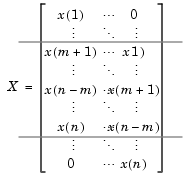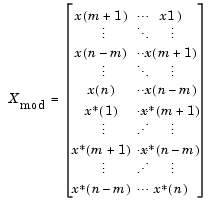

| Signal Processing Toolbox |   |
Compute a data matrix for autocorrelation matrix estimation.
Syntax
X = corrmtx(x,m)
X = corrmtx(x,m,'method')
[X,R] = corrmtx(...)
Description
X = corrmtx(x,m)
returns an (n+m)-by-(m+1) rectangular Toeplitz matrix X, such that X'X is a (biased) estimate of the autocorrelation matrix for the length n data vector x.
X = corrmtx(x,m,' computes the matrix method')
X according to the method specified by the string 'method':
'autocorrelation': (default) X is the (n+m)-by-(m+1) rectangular Toeplitz matrix that generates an autocorrelation estimate for the length n data vector x, derived using prewindowed and postwindowed data, based on an mth order prediction error model.'prewindowed': X is the n-by-(m+1) rectangular Toeplitz matrix that generates an autocorrelation estimate for the length n data vector x, derived using prewindowed data, based on an mth order prediction error model.'postwindowed': X is the n-by-(m+1) rectangular Toeplitz matrix that generates an autocorrelation estimate for the length n data vector x, derived using postwindowed data, based on an mth order prediction error model.'covariance': X is the (n-m)-by-(m+1) rectangular Toeplitz matrix that generates an autocorrelation estimate for the length n data vector x, derived using nonwindowed data, based on an mth order prediction error model.'modified': X is the 2(n-m)-by-(m+1) modified rectangular Toeplitz matrix that generates an autocorrelation estimate for the length n data vector x, derived using forward and backward prediction error estimates, based on an mth order prediction error model.[X,R] = corrmtx(...)
also returns the (m+1)-by-(m+1) autocorrelation matrix estimate R, calculated as X'*X.
Examples
randn('state',1); n=0:99;
s=exp(i*pi/2*n)+2*exp(i*pi/4*n)+exp(i*pi/3*n)+randn(1,100);
X=corrmtx(s,12,'mod');
Algorithm
The Toeplitz data matrix computed by corrmtx depends on the method you select. The matrix determined by the autocorrelation (default) method is given by the following matrix.

In this matrix, m is the same as the input argument m to corrmtx, and n is length(x). Variations of this matrix are used to return the output X of corrmtx for each method:
'autocorrelation': (default) X = X, above.'prewindowed': X is the n-by-(m+1) submatrix of X that is given by the portion of X above the lower gray line. 'postwindowed': X is the n-by-(m+1) submatrix of X that is given by the portion of X below the upper gray line. covariance': X is the (n-m)-by-(m+1) submatrix of X that is given by the portion of X between the two gray lines. 'modified': X is the 2(n-m)-by-(m+1) matrix Xmod shown below. 
See Also
peig |
Estimate the pseudospectrum using the eigenvector method. |
pmusic |
Estimate the pseudospectrum using the MUSIC algorithm. |
rooteig |
Estimate frequency content and signal power using the root eigenvector method. |
rootmusic |
Estimate frequency content and signal power using the root MUSIC algorithm. |
xcorr |
Compute the cross-correlation. |
References
[1] Marple, S.L. Digital Spectral Analysis, Englewood Cliffs, NJ, Prentice-Hall, 1987, pp. 216-223.
 | corrcoef | cov |  |